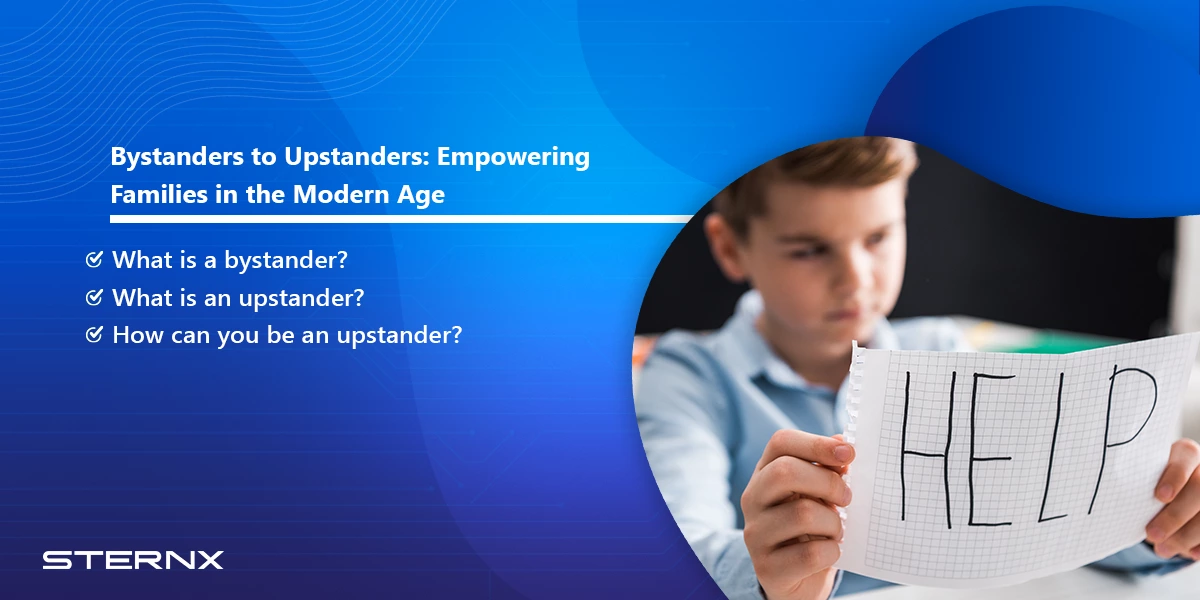As our lives become increasingly digital, protecting your family from online threats has found a new meaning. With kids spending more time on the internet, understanding how to protect them from online threats becomes essential. Digital safety has become a necessity for families. Traversing the online world involves more than just knowing how to use technology. It involves understanding the roles we play. In digital environments, there are upstanders and bystanders. The distinction between bystander and upstander is critical; while bystanders remain passive, upstanders actively address and counteract negative behaviors. Knowing the difference can make all the difference in ensuring a safer online experience for your family.
Table of Contents
ToggleWhat Is an Upstander?
An upstander is someone who takes action to support others, especially in the face of injustice or in bullying situation. Unlike a bystander who remains passive, an upstander steps in to help, making a positive impact on the situation.
The term “upstander” has its roots in social justice movements, where individuals stood up against oppression and advocated for change. In today’s digital age, online interactions can have big impacts in real life.
In physical spaces, an upstander might intervene when they see a person being bullied in a school environment or anywhere else. Online, an upstander could report cyberbullying or support a friend who is being harassed. Whether in person or digitally, upstander behavior promotes a safer and more supportive environment for everyone.

Differences Between Upstanders and Bystanders
A bystander is someone who witnesses an event, often a negative one, but chooses to remain passive and inactive. This inaction can stem from fear, uncertainty, or the belief that someone else will intervene. Bystanders, though present, do not take steps to address or stop the situation.
The primary difference between upstanders and bystanders is action versus inaction. Upstanders actively step in to help, while bystanders remain on the sidelines. Upstanders actively help victims and address wrongs, making a positive impact. Bystanders, on the other hand, allow negative behavior to continue by staying silent.
Psychological and social factors play significant roles in determining whether someone becomes an upstander or a bystander. Fear of retaliation, peer pressure, and a lack of confidence can deter any individual from acting. Conversely, empathy, a strong sense of justice, and social support encourage upstander behavior.
Consider a scenario in a school where a student is being bullied. A bystander might watch silently, hoping someone else will intervene. In contrast, an upstander would report the incident to a teacher or stand up to the bully directly.
Online, a bystander might ignore a cruel comment, while an upstander would call out the behavior and offer support to the victim. These actions define the crucial difference between perpetuating harm and fostering a supportive community.
Bullying Prevention and Anti-Bullying Measures
Bullying, whether it happens in school environment or online, remains a widespread issue. According to StopBulying.gov, around 20% of students aged 12-18 experience bullying in school, with about 15% encountering cyber bullying through digital platforms like social media and text messages. Pew Research Center reports that this issue is particularly pressing for teens, with 53% identifying online harassment as a major problem.
Upstander intervention can significantly mitigate bullying. When peers step into stopping or reporting bullying, the majority of the incidents can be halted. Upstanders help create a supportive environment, showing that active involvement can deter bullies and provide essential support to victims
Research highlights the impact of upstander actions in reducing bullying. For example, when students act as upstanders, schools report a noticeable decrease in bullying incidents. Programs that encourage upstander behavior have led to significant reductions, showing the power of active engagement in stopping bullying.
Upstanders can take several practical steps to stop bullying. Online, they can report bullying behavior, support the victim with positive messages, and block or unfollow the bully. In schools, they can inform teachers, stand by the victim, and assertively confront the bully. Encouraging kids to be upstanders equips them with the tools to make a positive difference and stop bullying.
Guide Your Child to Be an Upstander
Encouraging your child to be an upstander, rather than a bystander, involves active guidance and support. Here are some practical tips for promoting upstander characteristics in your children:
- Open Communication
Regularly talk to your child about their day and any challenges they face. Open communication builds trust, making it easier for them to feel comfortable to discuss issues like bullying. Encourage them to share their feelings and listen actively to show that their concerns are important.
- Set a Positive Example
Children learn by observing. Model upstander behavior in your own interactions. Show kindness, stand up for others, and address unfair situations. Your actions will demonstrate the importance of taking a stand against injustice and supporting those in need.
- Promote Empathy
Engage in activities and discussions that help your child understand and share the feelings of others. Reading books and watching movies can help them see the world from various perspectives and help them develop a sense of empathy and responsibility.
- Teach Conflict Resolution
Equip your child with conflict resolution skills. Discuss ways to address conflicts calmly and assertively without resorting to aggression. Practicing these skills will prepare them to intervene effectively when witnessing bullying or other negative behaviors.
- Encourage Peer Support
Promote the idea of peer support and solidarity. Encourage your child to stand by their friends and others who are being bullied. Reinforce the message that they can make a significant difference by supporting their peers and creating a positive environment.
- Foster a Safe Environment
Create a home environment where your child feels safe and supported. A strong, supportive home foundation empowers children to act confidently and stand up for what is right outside the home.
By implementing these tips, parents can help their children develop the courage and empathy needed to be upstanders, contributing to a safer and more supportive community for everyone.

Fostering Upstander Behavior in Schools
Schools play a pivotal role in promoting upstander behavior among students. By implementing effective programs and building a collaborative environment, schools can help students develop the skills and confidence to take action against bullying. Understanding the difference between a bystander and upstander is crucial. Here are some practical tips for schools:
- Implement Social-Emotional Learning (SEL) Programs
Social-emotional learning (SEL) programs teach students crucial skills like empathy, self-awareness, and social awareness. These programs create a foundation for students to understand and respond to the emotions of others, encouraging them to act as upstanders. Integrating SEL into daily routines and curricula helps reinforce these values throughout the school day.
- Build a Positive School Climate
A positive school climate reduces bullying and encourages inclusivity. Schools can achieve this by creating safe, supportive environments where all students feel valued. Certain activities and programs provide valuable tools to promote pro-upstander behavior and maintain a healthy school atmosphere.
- Train and Support Teachers
Teachers are crucial in modeling and encouraging upstander behavior. Providing professional development and resources on how to deal with bullying in bullying situation, manage classroom dynamics, and support students can make a significant difference. Training should include strategies for identifying bullying, intervening safely, and promoting a culture of respect and empathy.
- Engage Students in Anti-Bullying Activities
Engaging students in interactive activities and discussions about bullying can raise awareness and foster a sense of responsibility. There are programs that offer structured lessons that help students understand the impact of bullying, recognize different types of bullying, and develop the courage to intervene safely.
- Promote Collaboration Between Parents and Educators
Collaboration between parents and educators strengthens the support system for students. Regular communication with families about school policies, bullying incidents, and ways to support upstander behavior at home is very productive. Schools can also organize workshops and provide resources to help parents reinforce these values outside school.
SternX: Tools for Raising Digital Upstanders
At SternX, we offer comprehensive digital security tools and IT management services tailored for families. For instance, our parental control software, Safes, is designed to provide robust monitoring tools, ensuring your children’s online activities are safe and secure.
Our Safes program includes features specifically aimed at fostering upstander behavior. By creating a safe online environment, we encourage children to report and address cyberbullying and other online issues. We also provide resources that teach kids the importance of standing up for others.
Conclusion
Upstanders play a crucial role in promoting a safe digital environment. By actively intervening and supporting those who are bullied, they help create a culture of empathy and respect. Encouraging children to be upstanders can significantly reduce bullying and its harmful effects.
Parents and schools must take steps to foster upstander behavior. Open communication, supportive environments, and targeted programs can empower children to stand up against bullying behaviours. Together, we can build a safer and more inclusive digital world for our children.
